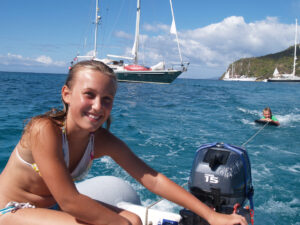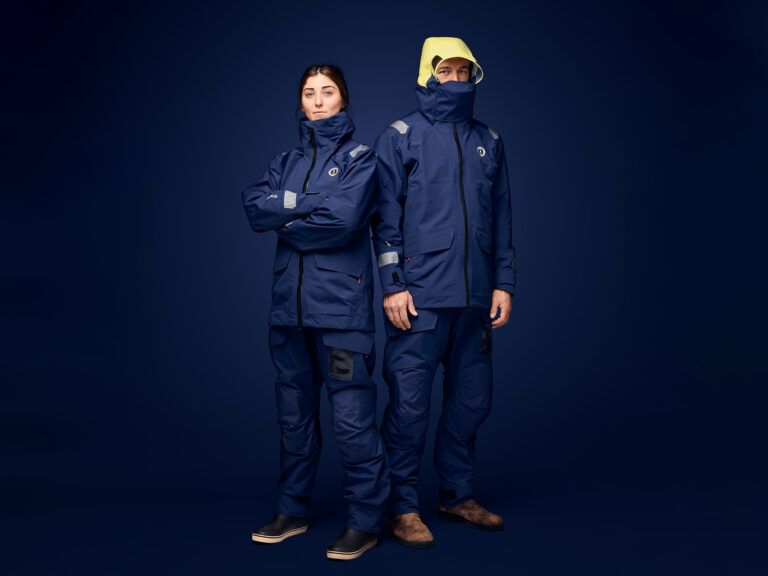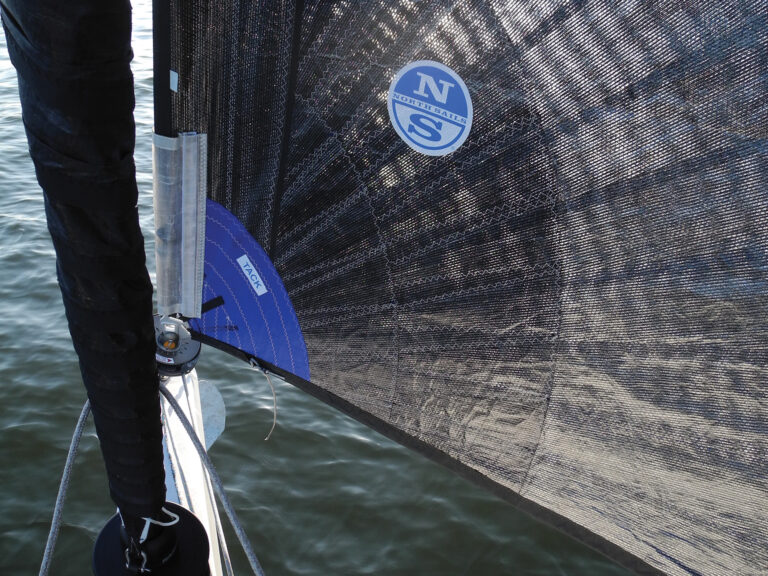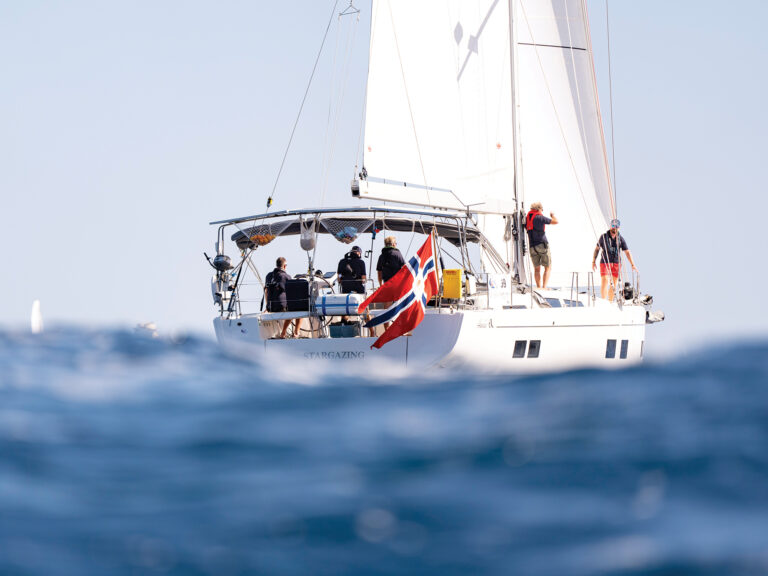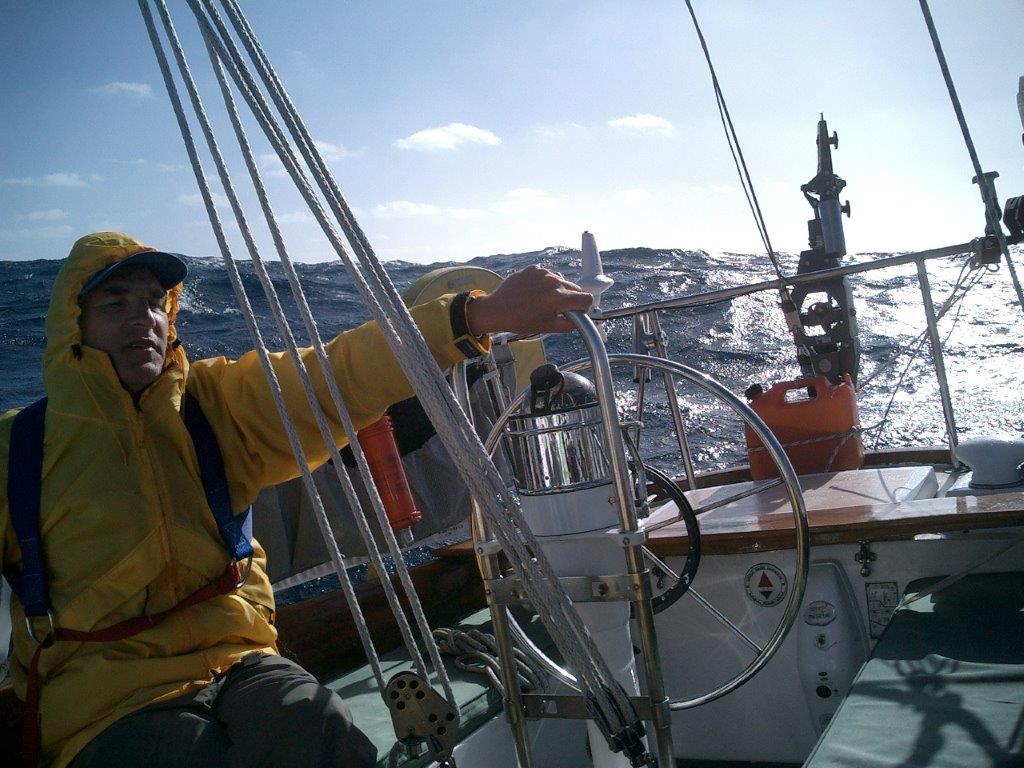
According to my journal, Nottoway was seven days out from Horta, Azores, heading due east toward Cascais, Portugal. So far it had been a relatively uneventful sail, with weather doing a little bit of this and that. Nottoway is a Ted Hood-designed Bristol 40 built in the early 1970s (see “Commuter Cruising 101,” March 2016). With a full keel and centerboard, she is comfortable in troubling seas, but the loss of the centerboard on the crossing from Maine to the Azores had brought her age and overall condition into question.
With a new centerboard fashioned in Horta, Nottoway was behaving beautifully as the wind and seas began to rise. It was late June, and we were less than 180 miles from the coast. That evening our crew of three, skipper Spencer Smith, David Yezzi and I, took bets on when we would make landfall. The challenge to the calculation was how much the head wind would push us south of our mark, but we all figured on arrival within 36 hours. When I came on watch at midnight, the wind was blowing 20-plus knots, and we opted to reef to make the night a bit more comfortable. By the midday watch, however, winds had grown to between 30 and 40 knots, and remained there for nearly three days. So much for the bet.
This is not the telling of a disaster at sea, but rather of three guys and a boat pulling together in trying conditions. Here was our challenge: Wind speeds were up to 40 knots, and the waves had built to between 15 and 20 feet. We were under bare poles except for a little bit of the roller-furling jib showing. With the hanky-size sail set, and having lashed the wheel to windward, we maintained an upwind zigzag course of about 1 knot, just enough to keep steerage way on. Where we wanted to go was east, directly upwind. Yet we were nearing the Gibraltar shipping lanes and weren’t exactly the most visible thing out there, especially in the wave troughs. So we decided the only way to get where we wanted to go was to cross the shipping lanes at a right angle, as quickly as possible.
North-south ship traffic coming in and out of Gibraltar can be heavy, and we worried that our dark green, low-profile sailboat under bare poles would be easily missed. Even if we could increase our way by 3 to 4 knots, we would be sitting ducks for many hours as we crossed over. There was also the boat to consider. She was old, and the previous experience of losing the centerboard had cast some doubt on how much abuse she could take. Adding speed and going into the wind under those sea conditions would only add stress to an already hardworking vessel. So we decided to wait out the storm. The hope was to maintain our position as best we could; however, wind and current were slowly carrying us south. And who knew at the time that the conditions more than 48 hours later would be unchanged? If anything, the waves had time to build more.
With a crew of three, watches were solo — not that there was that much to do. Nottoway was behaving well and rode comfortably. On occasion larger rollers would slam into the port side, sending a shudder through the boat. We had our fingers crossed that Nottoway would take the abuse. We were all in various degrees of dampness, and it was hard to stay warm, especially during night watches. In addition, I am prone to seasickness, and even with Dramamine I felt best in my bunk or on deck.
During the day, our paths would cross, especially at watch changeover, but at night, except for the handing over, you were on your own. We kept a deck watch at all times and always had our harnesses buckled in. I would huddle up next to the companionway to keep in the lee of the dodger because at night there was no way to see what sweep of water was coming your way. Watches were shortened to three hours after dark, but with the boat buttoned up and no light, the sense of aloneness was intense. It wasn’t a terrible feeling, but decidedly unnerving and not something I had ever experienced before. Add to this the noise and the fact that we were still 100 miles west of Portugal, and it was like being on another planet.
Noise and sailing have never mixed well with me — the louder it is, the more anxious I become. And it was noisy, especially at night. When you can’t see a thing and your only sense is hearing, sound intensifies. The wind was howling as we climbed a wave, then quieted down as we reached a trough. The rigging was singing, and the crash of breaking waves was all around. We were sitting on deck in almost complete darkness, hunkered down as much as possible to avoid the weather, feeling damp and cold and wondering if it would ever end. I remember shouting at the top of my lungs on one night watch, “Would you please stop?!” I didn’t have to worry about waking Spencer, David or, apparently, whoever was in charge of the storm.
On our third evening, with no change in the weather, we’d had it. Our drifting had slowly pushed us south, and there was little chance of fetching Cascais. It was around suppertime — cold baked beans and peanut butter sandwiches — and I was coming on watch for David. Spencer was poring over the chart, and suddenly proposed the idea of running down to Lagos, at the southern tip of Portugal. Finally, here was a chance to be proactive, and we jumped at it. Under more sober reflection, we might have opted to wait for daylight, but as Samuel Johnson said when asked about sailing nearly 300 years ago, “Being in a ship is being in a jail, with the chance of being drowned.” We were going to make a jailbreak.
We estimated we would arrive at the Gibraltar shipping channel just before dawn. As it was my watch to start, I unlashed the wheel and headed off. Our tuft of jib was just enough to nearly match the wave speed. After three days of doing nothing, absolute concentration and maximum effort were now required. Running before 15- to 20-foot waves is quite an experience, especially in the nearly pitch dark. The waves were invisible except when a top would break and run whitewashed down the face, the phosphorescence in the white water and the reddish hue of the binnacle light contrasting with the near-blackness of the night. These were the waves we had to watch out for. First would come the noise, like a small avalanche of water. The broken wave tops gathered speed as they spilled down the face, sometimes lunging into the cockpit. The feeling of closeness to the sea was magnified by the low profile of the boat itself, so unlike today’s high-freeboard designs. Even with weather cloths secured to the lifeline stanchions, the proximity to the waves felt very real, as if I could reach out and touch them. It made for a lively ride that drew me in completely with our surroundings.
Later that night, as we approached the shipping lanes, we doubled up on the watches in case contact was needed with any ships bearing down on us. Ships don’t always respond when called, but the effort would need to be made anyway because a 40-foot sailboat would not fare well in a collision with a 1,000-foot tanker. Just as David was stepping to the wheel, a particularly large wave of green water ran over the transom and flooded the cockpit. It knocked the EPIRB off its bracket and into the rather full footwell. Our immediate concern was that the action had activated it, transmitting a distress signal to all passing craft. Luckily, upon retrieval we found that the switch had not been tripped. It was just another moment of stress that wasn’t needed. Here we were, flying by the seat of our foul-weather pants — cold, wet, slightly seasick, tired and beaten down, dealing with conditions that were mostly new to us. There was no panic or fear, but anxiety was in the air, and it’s safe to say we weren’t having much fun.
David and I exchanged shifts on the wheel about every half-hour. While one of us drove, the other huddled under the lee of the dodger, dozing as best as one could. Our skipper, Spencer, had been awake throughout most of the previous 36 hours and was finally getting some much-needed naptime in the quarter berth. When I last took over, the eastern sky was just beginning to brighten.
With dawn came hope for our tired spirits, and the wind finally began to drop. We had successfully crossed most of the shipping lane and were now about 25 miles off the southwest coast of Portugal. David could go below and get some real sleep, and I had the boat to myself. What followed was probably one of the most exhilarating sails of my life. I smiled at our good fortune and how well the boat and crew had fared. Spencer relieved me around 0600, and when I came back on deck at 1000, there in the distance were the headlands of Cabo de São Vicente, with our destination of Lagos only about 25 miles farther on.
Our high spirits carried us for this last leg. Five hours later, as we rounded the corner near the entrance to Lagos, we were met with a surreal sight. At the mouth of the harbor are a series of caves carved out by the waves. The place is a vacation destination, and a number of wooden fishing boats converted for sightseeing bobbed around the entrance. They were brightly painted in blues, reds, oranges and yellows, and filled with swimmers and sunbathers shouting and laughing in the sun. It was like landing back on Earth after a trip to Mars.
Anthony Irving is a forest ecologist by trade, but sailing has always been a constant, including on long-ago stints on the schooner America and the hermaphrodite brig Black Pearl. He has sailed extensively throughout New England and parts of Europe, most recently in the Mediterranean.




